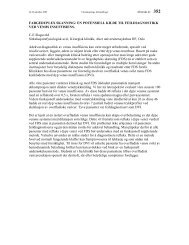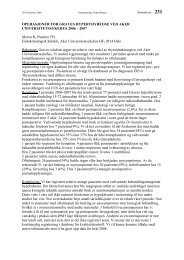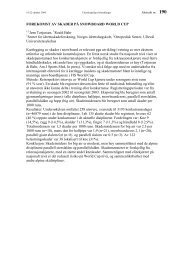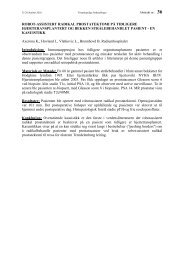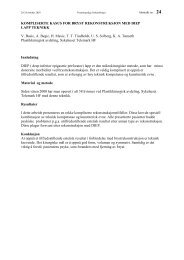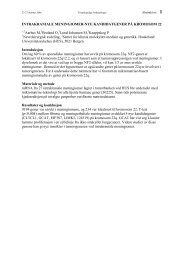25-Abstrakt-180-207.pdf
25-Abstrakt-180-207.pdf
25-Abstrakt-180-207.pdf
You also want an ePaper? Increase the reach of your titles
YUMPU automatically turns print PDFs into web optimized ePapers that Google loves.
20-24 oktober 2008 Vitenskapelige forhandlinger <strong>Abstrakt</strong> nr: 206<br />
LIMB ISCHEMIA AFTER ILIAC LIGATION IN AGED MICE STIMULATES<br />
ANGIOGENESIS WITHOUT ARTERIOGENESIS<br />
Westvik TS, Fitzgerald TN, Muto A, Maloney SP, Pimiento JM, Fancher TT, Magri D,<br />
Westvik HH, Nishibe T, Velazquez OC, Dardik A<br />
Departments of Surgery, and the Interdepartmental Program in Vascular Biology and<br />
Therapeutics, Yale University School of Medicine, New Haven, CT,<br />
Saint Mary’s Hospital, Waterbury, CT,<br />
Fujita Health University, Toyoake, Aichi, Japan,<br />
The Miller School of Medicine at the University of Miami, Miami, FL,<br />
The VA Connecticut Healthcare System, West Haven, CT.<br />
Objective(s): Older patients are thought to tolerate acute ischemia more poorly than younger<br />
patients. Since aging may depress both angiogenesis and arteriogenesis, we determined the<br />
effects of age on both angiogenesis and arteriogenesis, in a model of severe acute limb<br />
ischemia.<br />
Methods: Young adult (3 month) and aged (18 month) C57BL/6 mice underwent right<br />
common iliac artery and vein ligation and transection. Data were collected on days 0, 7, and<br />
14. Perfusion was measured with laser Doppler and compared to the contralateral limb.<br />
Functional deficits were evaluated with the Tarlov scale. Capillary density and endothelial<br />
progenitor cell (EPC) number were determined by direct counting; angiography was<br />
performed to directly assess arteriogenesis.<br />
Results: Young adult and aged mice had a similar degree of decreased perfusion after iliac<br />
ligation (young, n=15: 20.4±1.9%, vs. old, n=20: 19.6±1.3%; p=.72, ANOVA); however,<br />
young mice recovered faster and to a greater degree than aged mice (day 7, 35±6% vs.<br />
17±4%, p=.046; day 14, 60±5% vs. 27±7%, p=.0014). Aged mice had worse functional<br />
recovery by day 14 compared to young mice (2.3±.3 vs. 4.3±.4; p=.0021). Aged mice had<br />
increased capillary density (day 7, 12.9±4.4 vs. 2.8±0.3 capillaries/hpf; p=.02) and increased<br />
number of EPC incorporated into the ischemic muscle (day 7, 8.1±0.9 vs. 2.5±1.9 cells;<br />
p=0.007) compared to young mice, but diminished numbers of collateral vessels to the<br />
ischemic limb (1 vs. 9; p=0.01), as seen on angiography.<br />
Conclusions: After severe hindlimb ischemia, aged animals become ischemic to a similar<br />
degree as young animals, but aged animals have significantly impaired arteriogenesis and<br />
functional recovery compared to younger animals. These results suggest that strategies to<br />
stimulate arteriogenesis may complement those that increase angiogenesis, and may result in<br />
improved relief of ischemia.



